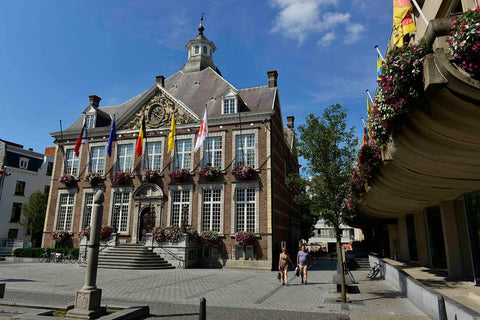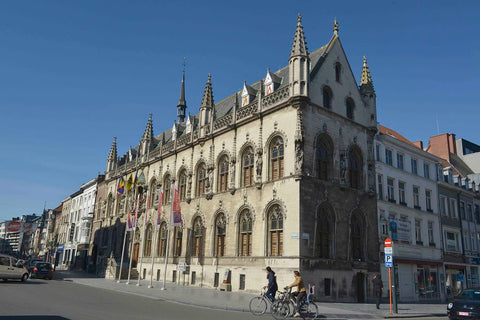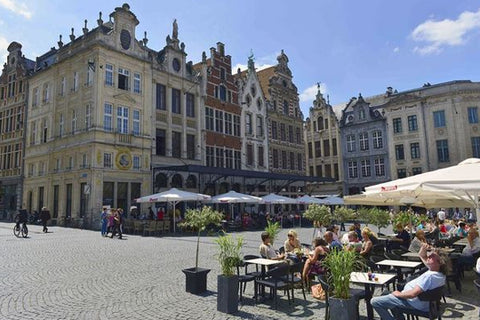- No products in the cart.
Tongeren

Tongeren is a town that has put down long roots into the bedrock of Belgium's history; it is reckoned that this is the oldest town in the country. It's also a town slap-bang in the middle of the fertile Limburg soils that have made it the biggest fruit-growing region in Belgium – and one of the largest in Europe too.
Cherries are one of the top crops here, a fact that has many on the more 'fruity' end of the Belgian beer-crowd smacking their lips. True Lambic krieks, even if not brewed around here, are a real passion for Limburg and Tongeren.
The 'Haspengouw' is what they call the gently rolling plateaux and hills of southern Limburg. It is a landscape of orchards and castles, open fields and marl-mines, a rural retreat in the 'middle east' of Belgium – villages where Dutch is spoken, and where the Netherlands is just a few strides to the right.
Tongeren is its main town, and Tongeren is also the home of a proper Belgian hero. Ambiorix, the leader of the Eburones a tribe who wiped out one of Julius Caesar’s legions, came from near Tongeren. They're proud of that connection here, and there's a museum dedicated to the era when the local woods were part of the tussle between Romans, Gauls and Germanic tribes.
Now Tongeren is known for its sleepy rural charm, a small town with little pieces of history's jigsaw scattered about its quiet streets.
It's also famous for trading on that history, with antique dealers from across Europe descending on it for a weekly 'flea' market – one that's anything but flea-sized. Tongeren has a Tourism Office located in the Julianusshopping right in the centre of the town. For opening hours, tips, advice, tours and much more visit their webpage or check Toerisme Limburg.
History

And as history has to start somewhere we start in Tongeren with a jug of original "Iron Brew". No, not the Scottish beverage, made from girders, but a bubbling spring made famous in ancient times by the Roman writer, Pliny the Elder.
He wrote about the home of the Tungri – the Germanic tribe living in the area – as having a fountain “of great renown, which sparkles as it bursts forth with bubbles innumerable, and has a certain ferruginous taste.”
He could have been talking about the local beer. But it is thought he actually meant an iron-rich spring, a mile or so from Tongeren. The 'Pliny Bron', as it was called, continued to be a draw for its medicinal properties until Napoleon's arrival in the area.
The Romans didn't just write about Tongeren – they had a huge role in shaping its history. It was Julius Caesar's reference to 'Aduatuca', as the fort and capital town of the Eburones (the Tungri's predecessors), that gave the town its 'oldest in Belgium' claim.
After Julius Caesar defeated the Eburones, it became the capital of a Roman province covering Limburg, and it was called Aduatuca Tungrorum. Over the years Tungrorum became Tongeren. It also became very rich, with its fertile soils providing bountiful harvests and a flow of trade with the rest of the Empire.
Being something of a border town, with hostile Germanic tribes close by, Tongeren suffered from occasional raids, and a destructive fire at the time of the Batavian Revolt of 70 AD. The Romans built 25-foot high walls to keep invaders out – and remains of these are still preserved in parts of Tongeren.
As the Empire declined in the 4th century, Tongeren became one of first places in north Europe to become a centre of Christianity, gaining a bishop called Saint Servatius. The remains of his church can be found underneath Tongeren's Basilica of Our Lady. After those early heydays, Tongeren hit something of a slippery slope.
The Roman town was destroyed by the Huns in 451 AD, and they were followed by waves of Germanic tribes intent on plundering (and then settling) across the Roman Empire.
Tongeren didn't really recover in importance until the 13th century, when its famous basilica, beguinages, medieval wall, and defensive towers were built – all under the protection of the Prince-Bishopric of Liège. Since then, apart from the occasional sacking by the French, Tongeren has managed to avoid the history pages, keeping to itself as a pretty, and perfectly-formed, corner of Belgian Limburg.
Getting There & Getting About

Tongeren sits a little off the beaten track in the far east of Belgium – north of Liege, west of Maastricht and south of Hasselt. If you want to get as close as you can by air, you could fly to Maastricht, across the Dutch border. Its airport is only 20 miles away, and is well-served by international connections.
Trains are best taken from the Liege side (Guillemins), as they only take 40 minutes to get here, as they wend up towards Antwerp.
Coming in from Brussels by train is usually more like one-and-a-half to two hours, taking a route via Hasselt. Tongeren lies off the main arterial road-routes, but is by no means hard-to-reach (or unfriendly to cars once you're there).
Once here, Tongeren is a small town that is perfectly easy to move around on foot, bike or by bus, so it's likely you'll be happy to ditch four wheels. Remember this province is well-equipped for cycling fanatics.
Accommodation
With only a little over 30,000 people, and sitting somewhat off the tourist trails, Tongeren isn't a town overflowing with hotel options. There are two small hotels in town – the Eburon Hotel, located in a former convent, and tilting a little towards the young crowd with its sharp-edged design and vibrant colours.
There's also the four-star Hotel Caelus VII, with its Beaus Arts facade, top-class rooms and special facilities for business travellers.
There are other hotels scattered around the surrounding countryside, villages and cities, which is also where you'll find some of the best B&B's. If you want even more choice, Maastricht has a thicket of them – both hotels and B&B's – and is only 20 minutes away by car.
Camping is also better done away from town, with the forests of the Hoge Kempen National Park, a few miles north, having several beautiful sites with excellent facilities. Please see our travel guide categories Hotels, B&B's for full details on accommodation possibilities.
For The Love Of Beer
_1600x1065.jpg?1363706636)
Tongeren may sit next to Belgium's biggest fruit-growing regions, and some of the country's best 'krieken' may get owe their tartness to cherries from Tongeren's neck of the woods. But when it comes to local-town breweries and craft-brewing sheds, Tongeren is a bit of desert. It wasn't always like this.
The amber light of fine local beers once shone brightly, with most recently the Stadsbrouwerij Au Phare, which only shut shop in 2013.
Its on-site brewed Amburon Blond and Amburon Pils were just gathering a head (as it were), before the owners were forced to pull the plug.
But Tongeren does lie right in the middle of a veritable 'tripel' of top-rated breweries – as long as you're prepared to travel a wee-way out of town. Nearest are two breweries in Sint-Truiden, 15 miles west. First up is Wilderen, a new brewery started by Mike and Roniek Janssen, which has a blonde, the Wilderen Goud, a kriek and a tripel, the Kannunik, on its books.
The latter has everything but the kitchen sink thrown in – barley, wheat, oats and rye, with two hop varieties and a 'secret blend' of spices, all bulked up to a hefty 8.2% ABV.
Another purveyor of 'specialities' is found at the other Sint-Truden brewer, Kerkom. With a slightly longer pedigree, reaching back to 1997, it has two 'gruut'-enhanced ales in its diverse repertoire – the Adelardus Dubbel and the Kerkomse Tripel.
It also has a peach-flavoured 'saison', the Bink Bloesem, and a cherry-infused beer – the Bloesem Kriek.
The other contender for a 'drive-to' is in somewhat different league – the St-Benedictus Abdij de Achelse Kluis. This is, of course, better known as Achel, the toddler of the Trappist six. Although it lies some 40 miles north of Tongeren, it does still sit within the same province of Limburg.
And it is the only Trappist experience that doesn't suffer from the shyness of its monks. You can visit the monastery of Achel anytime.
Its café looks out onto the inner workings of the monastic-brewery, and the famous to-ing and fro-ing of Brother Jules.
And if you don't fancy a long trek out-of-town to wet your beer-parched throat, Tongeren has a good complement of Flemish brown cafés and restaurants. It also has Brouwerij Bremans, an old brewery that is now a major stockist of Belgian beers from across the regions. Every desert, it seems, has its oasis.
Food & Gastronomy

This small town that likes to go big on its cuisine – but's that's the general approach to food across Limburg. Portions are large and presentation is simple, with no ingredients left off the menu – and every cook has their own 'special' blend of spices for the traditional Limburg dishes. That makes each new restaurant, in a place like Tongeren, akin to setting out on a completely different gastronomical journey.
Savoury Limburg dishes sometimes focus on that typically and traditional Flemish love of offal, but with the dial turned up to max. 'Head cheese', known locally as 'hoofdkaas' is a jellied brawn made from boiled pig-skull, which is eaten with bread and mustard.
Then there is 'balkenbrij', which starts with left-over stock from the making of sausages, which is boiled with flour, blood, bacon and other cuts such as liver, kidney and lungs.
These are ground and the 'rommelkruid' added (a special spice mix which might have liquorice, clove, ginger, cinnamon, mace, or sandalwood blended in), before the whole brew is cooled off in a bowl to make a 'balkenbrij loaf'.
Fish, veal and venison all feature in mains dishes, as does beef. Widely-eaten is diced-beef stewed in a tomato-based sauce, with plenty of local mushrooms. Another stew you'll find in Tongeren's restaurants is 'konijn in bier', or rabbit-in-beer, which is usually cooked with a sour Lambic. Popular side vegetables include white asparagus, water-cress and blanched chicory.
Sweet-tooths do well in Tongeren, especially lovers of biscuits. 'Caëderkükske' are coconut shortbreads shaped like a 20-sided dodecahedron (these are common artefacts from Roman times).
The Tongeren 'mop' is an aniseed-flavoured melt-in-the mouth treat. Both can be found in patisseries around town. For the chocolatiers, Tongeren has 'steenuil' , which are milk chocolate truffles encasing a selection of Haspengouw's famous fruits. Not far from Tongeren you can also visit the Sint-Lucie watercress farm, their produce is so unique they were awarded with a Protected Geographical Status under European Union Law.
Those same fruits also crop up in the delicious Loon syrup (or 'stroop') which is made from the reduced fruit juices of apples, pears and cherries – or even quinces or gooseberries. Excellent on pancakes and waffles. Some of the finest eating places in the area are listed in our Where to Eat category.
Shopping & Markets
Naturally Tongeren offers the small-scale shopping delights of a small Belgium town – daily market stalls, patisseries and bakers, boutique clothes and craft-shops – all alongside the usual chain-stores and big-brand names.
But Tongeren is also known continent-wide for its Sunday 'antiekmarkt', when up to 350 antique dealers line up under the town's ancient walls, ready to sell the best arts, crafts and antiques that European history has to offer.
The antique market has built on a strong tradition in antiquarian trading in the town – there are now reckoned to be nearly 40 antique shops in Tongeren, clustered mainly around the streets adjoining the Veemarkt (as well as along the Leopoldwal).
The market starts early, at 7am, and packs up around midday, so its definitely the case of the early bird catching the worm.
Though in this case the worm could be anything from iron tools to silverware, ceramics, vases and tiles to chandeliers and glassware – or even collectible tin-cans from a bygone era.
Sightseeing & Culture

Tongeren is known across Belgium as the oldest urban settlement in the country, and although little remains of those pre-Roman and Roman eras, there are still some parts of the inner town showing the rubbly remnants of Aduatuca Tungrorum (mainly pieces of its walls).
A somewhat enthusiastic 19th century bronze of Ambiorix, heroic slayer of Romans, strides over the Grote Markt, and helps sets the atmosphere.
But with so much going on, so early in Tongeren's history, the best way to get your head around it all is to visit the Gallo Roman Museum.
This modern museum building sits at the back of the Basilica of Our Lady, in the centre of town, and covers Tongeren's past from pre-history to the time the Romans left. The audiovisual presentations are second-to-none, helping bring to life its more than 2,000 objects from the past.
The adjacent Basilica of Our Lady stands as a beautiful and ancient contrast to the museum – and it also has its own collection of star attractions. The Basilica was built on the remains of a 4th century church, which was one of the first built in northern Europe.
The main church visible today is much later, a Gothic construction that was started in 1240, and which continued to be added to until the 15th century.
Among the treasures housed inside is the jewel-studded Reliquary Shrine of the Martyrs of Trier (from the thirteenth-century) which marked the martyrdom of local Christians, killed by the Romans a thousand years earlier. There's also a 6th century gold buckle from Merovingian times, and the 'Mariabeeld' herself – an elegant 15th century walnut statue of Our Lady of Tongeren – which is the Basilica's central object of veneration.
Tongeren’s is also famous for its large number of Beguines – women of means, mostly widows or without husbands, who retreated into the towns béguinage. It is thought that in the 17th century more than 250 Beguines lived here, and there is now a museum in one of the restored Beguine houses, on 'Onder de Linde'.
At its back is the rather pretty 13th century 'Clothmaker's Tower', part of the town's medieval defences, which was paid for by the Cloth-maker’s Guild.
Another remnant of defensive history is the Moerenpoort, built in 1379, and the last survivor of the tower-gates that guarded entrances around the town.
They were destroyed by the French in 1673, but the splendid tower of Moerenpoort was missed. It is now a museum of military history, and you can climb onto its upper parapet to get a great view over Tongeren.
Activities & Entertainment

Once you've seen the sights of Tongeren, it is the countryside surrounding it that beckons. It's not overly dramatic or loaded with spectacle, but it is pretty – its rolling farmland framed by occasional woods and wide open orchards, and spotted with castles and ancient landmarks.
The landscape is perfect for walkers looking to amble, or for cyclists looking to coast.
The local tourist board has setup a number of walks and cycle routes that thread from the centre of Tongeren, to the rural retreats outside – including the wooded 'Beukenberg' area, and beyond.
You can even hire bikes for free from the Tourist Office (there is a deposit required), which lets you explore the wider Haspengouw area. A great time to come is in April-May, when the fruit blossom is at its peak.
While out and about you'll no doubt see many orchards and even vinyards, especially near the village of Borgloon, a few miles to the west.
Many are open to the public, and some are even keen to get you involved in the fruit-harvesting. A little pick-your-own, Limburg style, is a great way to get into the Haspengouw swing of things.
MICE, B2B & Conferencing
Tongeren is not really geared up for big events, meetings and exhibitions, with only a small number of hotels, and no conference centres to speak of. Some excellent small-scale business facilities are provided by them, but for anything other than a small meet, it's best to head out to nearby Liege or some of the bigger Flemish cities.
The 'Meeting in Limburg' offices are especially focussed on helping businesses to develop their convention, meeting and exhibition ideas in the Limburg region.
They can advise on the logistical side of organising meetings and conventions, and suggest the best venues and locations.
They may even be able to help you with enquires on the availability of venues, or to help get you discounts and special offers from hotels, convention and exhibition centres, and group-booked restaurants.





